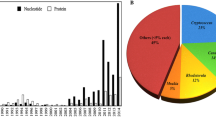Abstract
The study of the growth of the yeasts Rhodotorula rubra, Saccharomyces cerevisiae, and Debaryomyces vanriji at elevated temperatures and their survival after transient lethal heat shock showed that the ability of these yeasts to grow at supraoptimal temperatures (i.e., their thermoresistance) and their ability to tolerate lethal heat shocks (i.e., their thermotolerance) are determined by different mechanisms. It is suggested that the thermotolerance of the yeasts is mainly determined by the division rate of cells before their exposure to heat shock.
Similar content being viewed by others
REFERENCES
Arthur, H. and Watson, K., Thermal Adaptation in Yeast: Growth Temperatures, Membrane Lipid, and Cytochrome Composition of Psychrophilic, Mesophilic, and Thermophilic Yeasts, J. Bacteriol., 1976, vol. 128,no. 1, pp. 56-68.
van Uden, N., Temperature Profiles of Yeasts, Adv. Microb. Physiol., 1984, vol. 25, pp. 195-251.
Sanchez, Y. and Lindquist, S., HSP104 Required for Induced Thermotolerance, Science, 1990, vol. 248,no. 4959, pp. 1112-1115.
Aleksandrov, V.Ya. and Kislyuk, I.M., Cell Response to Heat Shock: A Physiological Aspect, Tsitologiya, 1994, vol. 36,no. 1, pp. 5-59.
Reinders, A., Romano, I., Wiemken, A., and De Virgilio, C., The Thermophilic Yeast Hansenula polymorpha Does Not Require Trehalose Synthesis for Growth at High Temperatures but Does for Normal Acquisition of Thermotolerance, J. Bacteriol., 1999, vol. 181,no. 15, pp. 4665-4668.
Borkovich, K.A., Farrelly, F.W., Finkelstein, D.B., Taulien, J., and Lindquist, S., Hsp82 Is an Essential Protein That Is Required in Higher Concentrations for Growth of Cells at Higher Temperatures, Mol. Cell. Biol., 1989, vol. 9,no. 9, pp. 3919-3930.
Zhdanova-Pushkina, S.M., Osnovy rosta kul'tur mikroorganizmov (Fundamentals of Microbial Culture Growth), Leningrad: Len. Gos. Univ., 1983.
Rikhvanov, E.G., Borovskii, G.B., and Voinikov, V.K., Synthesis of Heat Shock Proteins in Debaryomyces vanriji Cells Grown at Different Temperatures, Fiziol. Rast. (Moscow), 1997, vol. 44,no. 1, pp. 59-63.
Walton, E.F. and Pringle, J.R., Effect of Growth Temperature upon Heat Sensitivity in Saccharomyces cerevisiae, Arch. Microbiol., 1980, vol. 124,no. 2/3, pp. 285-287.
Piper, P.W., Molecular Events Associated with Acquisition of Heat Tolerance by the Yeast Saccharomyces cerevisiae, FEMS Microbiol. Rev., 1993, vol. 11,no. 4, pp. 339-355.
Thevelein, J.M. and de Winde, J.H., Novel Sensing Mechanisms and Targets for the cAMP-Protein Kinase A Pathway in the Yeast Saccharomyces cerevisiae, Mol. Microbiol., 1999, vol. 33,no. 5, pp. 904-918.
Iida, H. and Yahara, I., A Heat Shock-Resistant Mutant of Saccharomyces cerevisiae Shows Constitutive Synthesis of Two Heat Shock Proteins and Altered Growth, J. Cell. Biol., 1984, vol. 99,no. 4, part 1, pp. 1441-1450.
Iida, H., Multistress Resistance of Saccharomyces cerevisiae Is Generated by Insertion of Retrotransposon Ty into the 5′ Coding Region of the Adenylate Cyclase Gene, Mol. Cell. Biol., 1988, vol. 8,no. 12, pp. 5555-5560.
Shin, D.Y., Matsumoto, K., Iida, H., Uno, I., and Ishikawa, T., Heat Shock Response of Saccharomyces cerevisiae Mutants Altered in Cyclic AMP-Dependent Protein Phosphorylation, Mol. Cell. Biol., 1987, vol. 7,no. 1, pp. 244-250.
Davidson, J.F., Whyte, B., Bissinger, P.H., and Schiestl, R.H., Oxidative Stress Is Involved in Heat-Induced Cell Death in Saccharomyces cerevisiae, Proc. Natl. Acad. Sci. USA, 1996, vol. 93,no. 10, pp. 5116-5121.
Moore, M.M., Breedveld, M.W., and Autor, A.P., The Role of Carotenoids in Preventing Oxidative Damage in the Pigmented Yeast Rhodotorula mucilaginosa, Arch. Biochem. Biophys., 1989, vol. 270,no. 2, pp. 419-431.
Rikhvanov, E.G., Varakina, N.N., Sozinov, D.Y., and Voinikov, V.K., Association of Bacteria and Yeasts in Hot Springs, Appl. Environ. Microbiol., 1999, vol. 65,no. 9, pp. 4292-4293.
Elliott, B. and Futcher, B., Stress Resistance of Yeast Cells Is Largely Independent of Cell Cycle Phase, Yeast, 1993, vol. 9,no. 1, pp. 33-42.
Park, J.I., Grant, C.M., Attfield, P.V., and Dawes, I.W., The Freeze-Thaw Stress Response of the Yeast Saccharomyces cerevisiae Is Growth Phase Specific and Is Controlled by Nutritional State via the RAS-Cyclic AMP Signal Transduction Pathway, Appl. Environ. Microbiol., 1997, vol. 63,no. 10, pp. 3818-3824.
Populyarnyi biologicheskii slovar' (Popular Biological Dictionary), Reimers, N.F., Ed., Moscow: Nauka, 1990 (Russian translation).
Author information
Authors and Affiliations
Rights and permissions
About this article
Cite this article
Rikhvanov, E.G., Varakina, N.N., Rusaleva, T.M. et al. The Absence of a Direct Relationship between the Ability of Yeasts to Grow at Elevated Temperatures and Their Survival after Lethal Heat Shock. Microbiology 72, 423–427 (2003). https://doi.org/10.1023/A:1025036505147
Issue Date:
DOI: https://doi.org/10.1023/A:1025036505147




